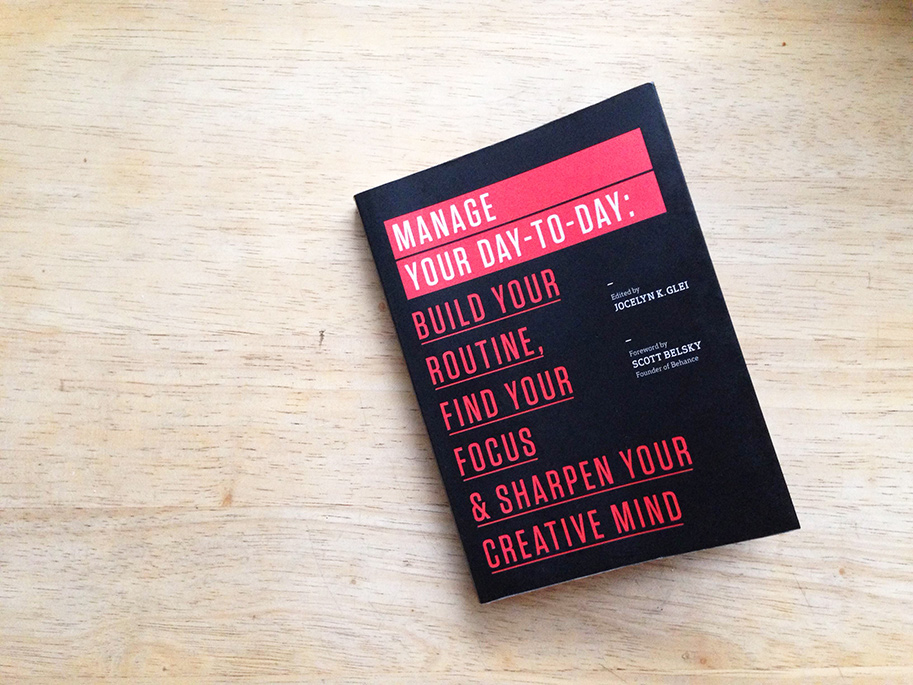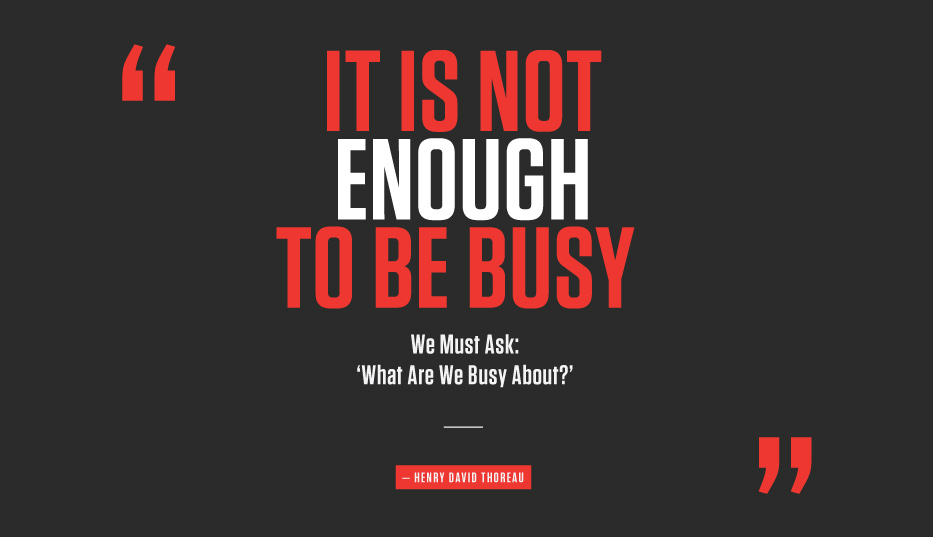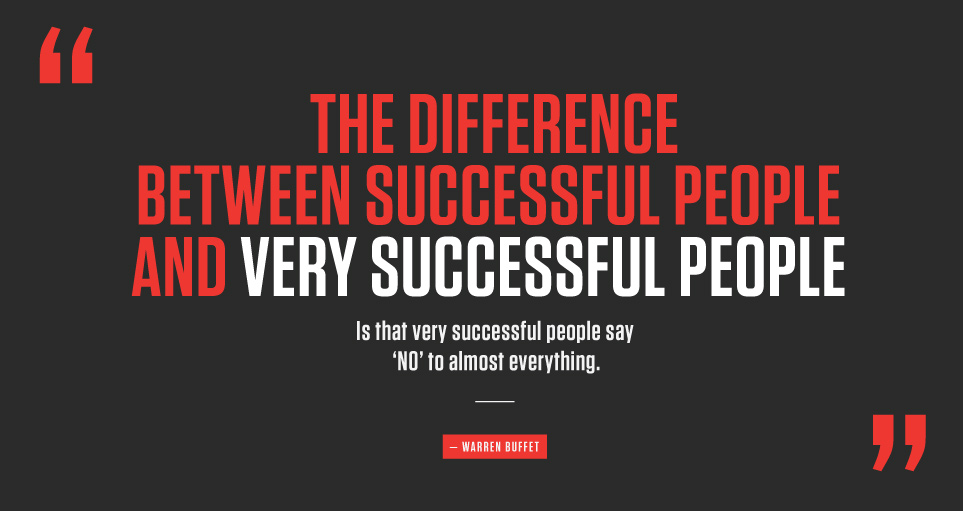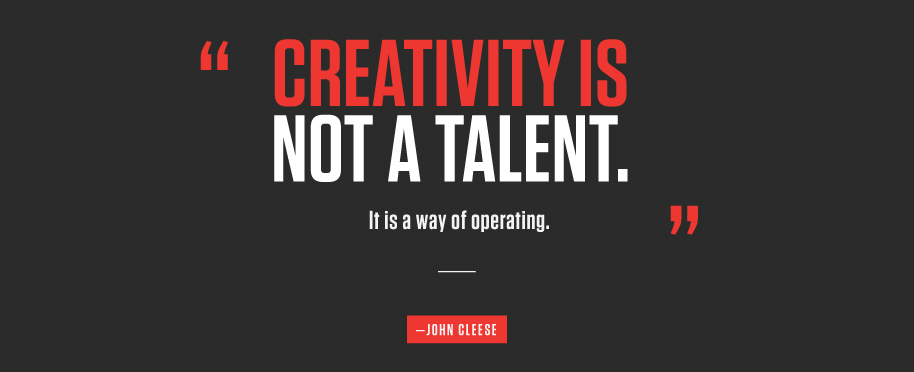One of the many benefits of being a designer is the wonderful groups locally and nationally that offer support, resources and education to anyone who joins. One of these excellent groups is Behance.
Over the summer Behance sent a delightful email, suggesting I buy the first edition of their 99U book series entitled Manage Your Day-to-Day. I am not always immediately jazzed about emails that go straight to my new promotions tab, but this one with the tagline, “build your routine, find your focus & sharpen your creative mind” had me taking out my credit card faster than a Firebolt on a Quidditch pitch.
Here is the book:

The reason I felt I needed the book as fast as I could get it? The 21st century is so distracting! There are so many things getting in the way of me and my best work—emails, texts, social media, blogs, GIFs, meetings. When does it end and my creative time begin? I was hoping to open the book and get a few life-changing tips, and my work life would be back on track to being the next Sagmeister. But this book is so much more than that—it’s a manifesto, a lifestyle. I can’t stop quoting this book to family, friends and coworkers (sorry) because it is just so darn good. And the best thing about it is—it’s short!
The book is based on four principal skills: building a rock-solid routine, taming your tools (before they tame you), finding focus in a distracted world and sharpening your creative mind. If you saw that last skill and thought, “I am not a creative individual…this book is not for me”—you’re wrong. This book is literally for anyone with work productivity issues, I promise.
Building a rock-solid routine
How to give structure, rhythm and purpose to your daily work.
KEY TAKEAWAYS
- Great work before everything else – In short, learn your body and when you have the most energy/motivation, and do your most important work then. Your drive will be stronger and you’ll be more likely to pump out some good work.
- Feel the frequency – Work diligently and often. It helps you creatively, makes starting easier and keeps you fresh.
- Pulse and pause – Know how to work hard, but then take breaks. In this part it’s mentioned that the brain really only can concentrate for 90 minutes at a time and then it needs a break. They suggest doing anything that can get your mind off work altogether and allowing your brain to wander. I usually clean my desk, dust something, empty the dishwasher or play with my cat.
- Get lonely – With mention of Henry David Thoreau’s famous solitary trip, Mark McGuinness, a coach for creative professionals, suggests we try to create our own solitude. Being alone allows us to get more acquainted with our inner beings and helps our creativity churn. He suggests meditation; I do it by riding my bike, running, yoga or just flat-out meditating.*
- Don’t wait for moods – You can’t sit and wait to be in the mood to work—chances are that will come less often than a Browns victory (sorry Brownies). So work no matter what—you’ll get in the mood once you start ;).
* A tip from a yoga instructor in college: Sit in the dark, however you feel most comfortable. Clear your mind of all thoughts and count starting from one. Every time your mind wanders from the numbers, start over. It’s really hard, but you’ll get the hang of it and get really good with clearing your mind. It is astonishing how hard this is.
Finding focus in a distracted world
How to hone your attention to produce work that really matters.
KEY TAKEAWAYS
- Defend your creative time – Set aside time in your schedule for you to work on the things that matter to you. Enter into your calendar that you have a meeting during that time so coworkers and clients know you’re off limits.
- Focus when you’re fresh – Put your most challenging work at the beginning of the day. Your motivation and self-esteem lower as the day goes on, so you never want to tackle something challenging at the end of the day.
- Kill the background noise – Meaning email, social media, games, your phone. Anything that can break your attention from the task at hand. They talk about some great studies where they asked two groups of people to work on a project with and without distraction, and of course, the people who had no distraction did better. They also mention that “multi-tasking” only exists in that we can walk and talk at the same time. We can’t work on two things at once—we can only switch very quickly (“task switching”) between projects and do both a little worse than we would have if we did them one at a time. If I may: “Don’t half ass two things, whole ass one thing” – Ron Swanson.
- Make progress visible – Set hard deadlines, and keep track of the work you accomplish. It makes it easier to keep moving forward. It also makes you feel a sense of pride when you get through your list!
- Tap into transitional moments – I really enjoyed this part—it talked a lot about how we are so obsessed with turning our transitional moments into catch-up time, that we don’t really have time to reflect about what we just learned. Also, he (Scott Belsky, Adobe’s Vice President) makes mention of our loss of serendipity since we all spend our commutes with our noses in our phones and our ears full of music. Take time and reflect instead, and maybe you’ll meet somebody new.
Taming your tools
How to gracefully manage new technologies for better workflow and well-being.
KEY TAKEAWAYS
- Keep the long view in view – Always know what your long-term goals are and set steps for how you are going to achieve them. Most importantly, hold yourself accountable.
- Be conscious of your bandwidth – Forget the idea that you have to catch up on every last Facebook or Instagram post you missed and just let yourself take in what’s in the here and now. This part is so wonderful: it talks about our social media obsession and asks the question—why? The writer of this chapter, Lori Deschene, challenges us to ask ourselves why we are logging on. In regards to our social media activity she asks, “Is it necessary to share this? Will it add value to my life and for other people? Can I share this experience later so I can focus on living in the now? Am I looking for validation, is there something I could do to validate myself? Am I bored/lonely? Afraid I am missing out or do I just want mindless fun for a while?” Distinguishing why you’re using social media is important, and she notes that if you are just looking for mindless fun, that is okay too.
- Hit the reset button – Go unplugged for an hour, a night, a weekend—help yourself reset.
- Don’t hold your breath – I shared this fact with everyone. When we sit in front of computers, many of us breathe slow or even hold our breath. Doing this triggers the sympathetic nervous system to enter a fight-or-flight state. “In this state the heart rate increases, our sense of satiety is compromised, and our bodies gear up for the physical activity that, historically, accompanied a fight-or-flight response. But when the only physical activity is sitting and responding to email, we’re sort of ‘all dressed up with nowhere to go'”. Pay attention to your breathing, and breathe long, deep breaths to prevent these unhealthy consequences!
Sharpening your creative mind
How to push through creative blocks and keep the aha moments coming
KEY TAKEAWAYS
- Practice unnecessary creation – Interested in trying out a new skill or technique? It is nice to be able to get risky with your work in a safe environment where you aren’t at risk for blowing a project. Doing this helps you get comfortable with these new techniques and hopefully hone the skill so you’re comfortable trying it at work.
- Define “finished” from the start – So you don’t kill yourself being a perfectionist. Set guidelines ahead of time so you stop when you have to—no excuses.
- Don’t go on autopilot – Don’t let yourself get comfortable doing the same thing over and over. Things that feel comfortable come easiest, but we have to step outside of our comfort zone—otherwise our work becomes predictable.
- Search for the source – A great tip, again. McGuinness says that when we hit a wall, we immediately think it’s lack of skill. Many times, especially for me, when I am stuck it’s really because I don’t know enough about what I am working on. I haven’t done enough research or sketches. But the second I do—the ideas start flowing.
- Love your limitations – From THE man himself—Stephen Sagmeister. A truly wonderful chapter, however I will only quote a quote of a quote. Discussing limitations in your work, be they client limitations or personal, Sagmeister quotes Brian Eno: “He says the electric guitar became the dominant instrument of the twentieth century simply because it’s such a stupid instrument. It can do so very little. But it can do a few things very, very well, and therefore it allows human nature to go to the edge of what’s possible.”
This book was truly career changing, and I hope those of you who are struggling to feel purpose in your work read it. You can buy it here. 99U has already created the second edition, which I cannot wait to read and share with you. Edition Two is entitled Maximize Your Potential: Grow Your Expertise, Take Bold Risks & Build an Incredible Career.
Until next time!
The images in this blog post are courtesy of 99u.












